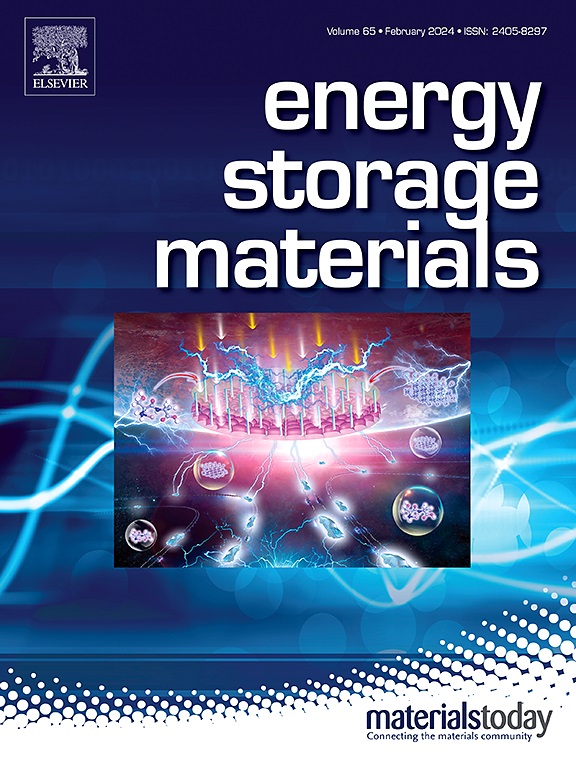Kinetic regulation of Zn(002) textured interfaces for highly reversible Zn–iodine batteries
IF 20.2
1区 材料科学
Q1 CHEMISTRY, PHYSICAL
引用次数: 0
Abstract
The commercialization of zinc-ion batteries is severely hindered by anode instability, as hydrogen evolution reactions and Zn dendrite growth lead to low Coulombic efficiency and short cycle life. Here, we propose a kinetic regulation strategy of spatial electrostatic field layer (EFL), based on the conjugated system of tetrasulfonated cobalt phthalocyanine (CoPcS4), to enhance the preferred Zn(002)-oriented deposition. Experimental characterizations and theoretical calculations confirm that CoPcS4 can preferentially adsorb on the electrode surface and form a stable solid electrolyte interface, which prevents zinc anode from the direct contact with aqueous electrolyte. The conjugated planar structure of CoPcS4 further generates a delocalized EFL, which promotes Zn2+ desolvation, accelerates ion transport, and ensures uniform electric field distribution. Moreover, it can effectively promote the preferred Zn(002) deposition and maintains a dense, smooth anode surface during cycling. This strategy achieves excellent cycling stability of 3500 cycles in Zn//Zn symmetry cells under extreme condition of 50 mA cm−2. In a Zn//I2 battery, it demonstrates exceptional stability even at an ultra-high current density of 50 C, highlighting its great potential in massive energy storage.


高可逆锌碘电池中Zn(002)织构界面的动力学调控
阳极不稳定性严重阻碍了锌离子电池的商业化,因为析氢反应和锌枝晶的生长导致了低库仑效率和短循环寿命。在此,我们提出了一种基于四磺化酞菁钴(CoPcS4)共轭体系的空间静电场层(EFL)动力学调控策略,以增强Zn(002)取向的优选沉积。实验表征和理论计算证实,CoPcS4能优先吸附在电极表面,形成稳定的固体电解质界面,防止锌阳极与水电解质直接接触。CoPcS4的共轭平面结构进一步产生离域EFL,促进Zn2+脱溶,加速离子输运,保证电场分布均匀。此外,它可以有效地促进Zn(002)的优选沉积,并在循环过程中保持阳极表面致密、光滑。该策略在50 mA cm−2的极端条件下,在Zn//Zn对称电池中实现了3500次的优异循环稳定性。在Zn/ I2电池中,即使在50℃的超高电流密度下,它也表现出卓越的稳定性,突出了其在大规模能量存储方面的巨大潜力。
本文章由计算机程序翻译,如有差异,请以英文原文为准。
求助全文
约1分钟内获得全文
求助全文
来源期刊

Energy Storage Materials
Materials Science-General Materials Science
CiteScore
33.00
自引率
5.90%
发文量
652
审稿时长
27 days
期刊介绍:
Energy Storage Materials is a global interdisciplinary journal dedicated to sharing scientific and technological advancements in materials and devices for advanced energy storage and related energy conversion, such as in metal-O2 batteries. The journal features comprehensive research articles, including full papers and short communications, as well as authoritative feature articles and reviews by leading experts in the field.
Energy Storage Materials covers a wide range of topics, including the synthesis, fabrication, structure, properties, performance, and technological applications of energy storage materials. Additionally, the journal explores strategies, policies, and developments in the field of energy storage materials and devices for sustainable energy.
Published papers are selected based on their scientific and technological significance, their ability to provide valuable new knowledge, and their relevance to the international research community.
 求助内容:
求助内容: 应助结果提醒方式:
应助结果提醒方式:


